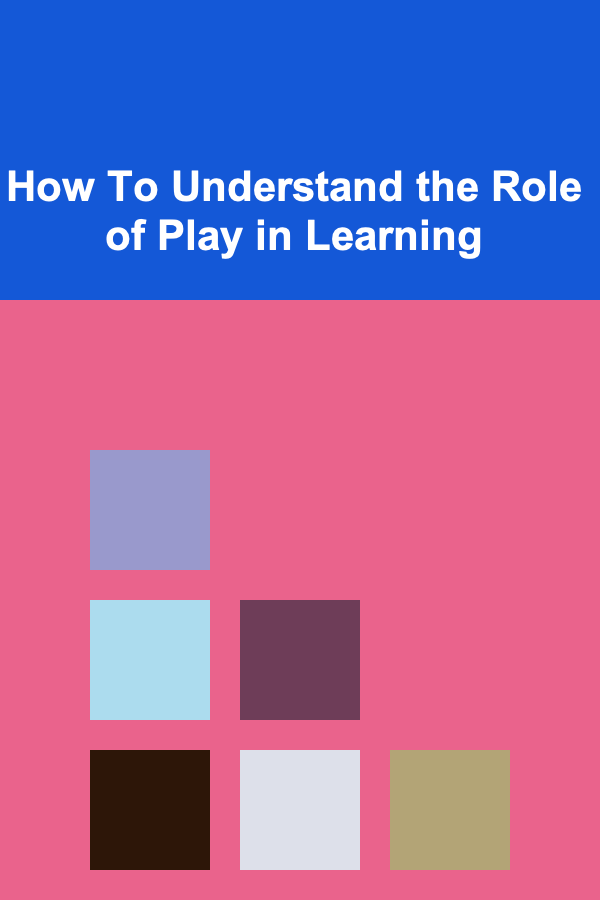
How To Understand the Role of Play in Learning
ebook include PDF & Audio bundle (Micro Guide)
$12.99$10.99
Limited Time Offer! Order within the next:

Play has always been a natural and integral part of human development. Whether it's a child interacting with toys, a teenager engaging in a sport, or an adult participating in leisure activities, play is ubiquitous across all stages of life. But when we think about learning, we often gravitate toward more structured, formal environments like classrooms, lectures, and textbooks. The role of play, however, is just as critical in facilitating learning, offering unique opportunities for creativity, engagement, and cognitive development. This article delves into how play functions as a powerful tool in learning, examining its theoretical foundations, benefits, and practical applications across different age groups and learning contexts.
The Psychological Foundations of Play and Learning
The connection between play and learning is not a recent discovery. In fact, one of the earliest advocates of play in learning was the Swiss psychologist Jean Piaget. Piaget's theory of cognitive development emphasizes the idea that children actively construct their knowledge of the world through interaction and exploration. Play, in Piaget's view, is a vital process through which children experiment with different ideas, understand abstract concepts, and develop problem-solving skills.
Moreover, Piaget categorized play into various stages, each representing different cognitive abilities. For example, during the sensorimotor stage (birth to two years), play focuses primarily on sensory exploration and motor skills. As children grow, their play becomes more complex, involving symbolic thinking, role-play, and social interaction.
Lev Vygotsky, another influential figure in the field of developmental psychology, built upon Piaget's ideas, suggesting that learning occurs most effectively in a social context. He introduced the concept of the "Zone of Proximal Development" (ZPD), which refers to the range of tasks a learner can perform with the help of a more knowledgeable individual (a teacher, peer, or even a toy). Play, according to Vygotsky, is a form of social interaction that allows children to engage in higher-order thinking and problem-solving beyond their current developmental level, pushing them into the ZPD and facilitating cognitive growth.
In the context of modern psychology, the idea of play as a learning mechanism aligns with the concept of constructivism, which posits that learners actively build knowledge through experiences. Play is inherently experiential, meaning that it allows learners to construct new knowledge through action, reflection, and problem-solving.
The Role of Play in Early Childhood Education
The importance of play in early childhood education cannot be overstated. For young children, play is more than just an enjoyable activity; it is a primary means of learning and a critical tool for developing foundational skills. In the early years, children are often too young to engage in formal education, and thus, play becomes the primary way for them to interact with the world around them.
Cognitive Development
Through play, children engage in cognitive processes that lay the groundwork for future learning. Play fosters attention, memory, and problem-solving abilities. Simple activities like building with blocks, playing dress-up, or completing puzzles require children to use spatial reasoning, planning, and trial-and-error approaches---all of which contribute to cognitive development. By engaging in imaginative play, children also explore abstract concepts, such as cause-and-effect relationships, without realizing they are doing so.
Social and Emotional Development
Play also serves as a critical vehicle for social and emotional development. It is in play that children first experience cooperation, conflict resolution, empathy, and negotiation skills. Through interaction with peers, they learn to navigate social norms and expectations, taking turns, sharing, and empathizing with others' feelings. Role-playing activities---whether playing house, pretending to be doctors, or acting out stories---help children understand diverse perspectives, which in turn nurtures emotional intelligence.
Language and Communication Skills
In early childhood, play is intimately connected with language acquisition. Children often engage in dialogues during pretend play, practicing new words, sentence structures, and forms of communication. Through conversations with peers or adults during play, children develop their vocabulary and gain a better understanding of how language works in social contexts. Storytelling, whether through puppet shows or role-playing scenarios, also encourages the development of narrative skills and comprehension.
Physical Development
While play often emphasizes cognitive, social, and emotional learning, it also plays a significant role in physical development. Outdoor play, for instance, provides opportunities for gross motor skills development through activities like running, climbing, and jumping. Fine motor skills are honed during activities such as drawing, building, or manipulating small objects. These physical skills, in turn, support a child's overall growth and ability to interact with their environment.
Play as a Learning Tool in Formal Education
While play is commonly associated with early childhood education, its role in learning extends far beyond the preschool years. The importance of play continues into elementary and even secondary education, albeit in different forms and contexts. Here, play serves to enhance engagement, motivation, and creativity while also reinforcing academic concepts.
Gamification in the Classroom
In recent years, the concept of gamification has gained popularity in educational settings. Gamification involves incorporating game-like elements (such as rewards, challenges, and competition) into non-game contexts, including the classroom. By integrating game mechanics, educators create environments where students are intrinsically motivated to engage with the material and persist through challenges. Games create opportunities for trial and error, helping students build resilience and problem-solving skills while learning academic content.
Simulations and Role Play
Another way that play manifests in formal education is through simulations and role-play exercises. Whether it's a mock trial in a history class, a business simulation in an economics course, or a role-playing activity in a language lesson, these immersive activities allow students to apply theoretical knowledge to practical scenarios. By stepping into different roles, students not only deepen their understanding of the subject matter but also cultivate critical thinking, collaboration, and communication skills.
Creative Expression through Play
Creative play, such as drama, music, and art, also has a place in formal education. These forms of play encourage students to explore their imagination, develop original ideas, and express their thoughts in diverse ways. For instance, in a literature class, students might engage in dramatic readings, or in a science class, they might build models to represent scientific concepts. These creative activities allow students to approach learning from a different perspective, breaking away from traditional, linear methods and engaging with the material in a more holistic manner.
The Role of Play in Adult Learning
While the link between play and learning is most obvious in children, adults can also benefit from incorporating play into their learning experiences. Lifelong learning is essential in today's rapidly evolving world, where new skills and knowledge are required to adapt to changing job markets and technologies. For adults, the role of play in learning can take on several forms, including gamified training programs, collaborative learning exercises, and creative problem-solving workshops.
Adult Learning in the Workplace
In the workplace, play can serve as a tool for professional development and team building. Many organizations are beginning to use playful learning experiences to foster innovation, collaboration, and creativity among employees. For example, companies may organize team-building activities, where employees are tasked with solving problems in fun and unconventional ways. Such activities help to reduce stress, improve communication, and encourage a more collaborative working environment.
Problem Solving and Innovation
Play, particularly in the form of simulations and "what-if" scenarios, can also help adults think outside the box and solve complex problems. For instance, design thinking workshops often involve role-playing, brainstorming, and prototyping---playful activities that encourage divergent thinking and creativity. These playful exercises allow adults to approach problems with an open mind, explore multiple solutions, and think more expansively.
Play and Lifelong Learning
Finally, play can be a crucial element of lifelong learning, especially for older adults who may not engage in formal education settings. Playful activities, such as hobby groups, puzzles, and creative workshops, can provide opportunities for continuous personal growth. These activities stimulate cognitive engagement, emotional well-being, and social interaction, all of which contribute to the ongoing learning process.
Conclusion
The role of play in learning is multifaceted and cannot be underestimated. From the earliest years of childhood through adulthood, play offers an invaluable way to engage, explore, and grow. Through play, learners develop essential cognitive, social, emotional, and physical skills that serve as the foundation for lifelong learning. Whether it's through imaginative play, gamification, role-playing, or creative expression, play has the power to transform the learning experience by making it more engaging, interactive, and enjoyable. As we continue to recognize the profound connection between play and learning, we must embrace playful approaches to education and support environments where learners of all ages can thrive.
Reading More From Our Other Websites
- [Organization Tip 101] How to Curate a Favorite Moments Album
- [Home Maintenance 101] How to Extend the Life of Your Coffee Maker
- [Home Staging 101] How to Stage Your Home for Seasonal Appeal
- [Screen Printing Tip 101] Essential Equipment Checklist for a Successful Screen Printing Studio
- [Toy Making Tip 101] How to Create a Fully Functional DIY Miniature Railway Using Popsicle Sticks
- [Organization Tip 101] How to Create a Home Gallery for Your Luxury Photography
- [Organization Tip 101] How to Store Vintage Home Décor Seasonally
- [Survival Kit 101] How to Use an Emergency Radio: A Complete Guide for Beginners
- [Organization Tip 101] How to Maintain Your Drip Irrigation System for Long-Term Performance
- [Organization Tip 101] How to Create a Detailed Inventory of Your Antique Collection

How To Choose the Right Insurance for Your FIRE Journey
Read More
How to Create a Tool Rotation System for Efficiency
Read More
The Supply Chain Analyst's Playbook: Essential Tools for Data-Driven Decisions
Read More
Statement Sleeves: A Deep Dive into Incorporating Them into Your Style
Read More
Identifying Birds by Their Unique Behaviors: A Comprehensive Guide
Read More
How to Plan a TV-Free Day (and Still Enjoy Your Shows)
Read MoreOther Products

How To Choose the Right Insurance for Your FIRE Journey
Read More
How to Create a Tool Rotation System for Efficiency
Read More
The Supply Chain Analyst's Playbook: Essential Tools for Data-Driven Decisions
Read More
Statement Sleeves: A Deep Dive into Incorporating Them into Your Style
Read More
Identifying Birds by Their Unique Behaviors: A Comprehensive Guide
Read More